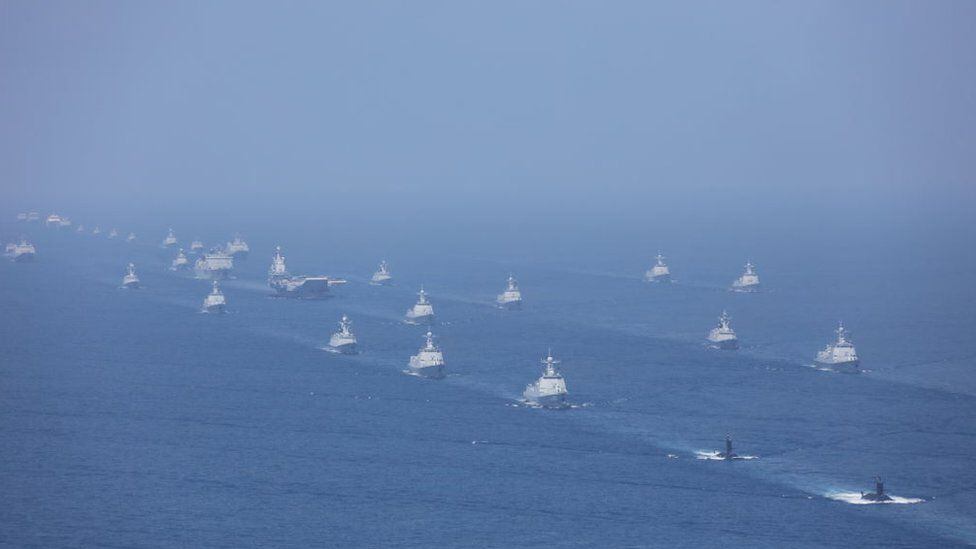Are fishing boats that they rarely fish and that, sometimes, they earn money just by dropping anchor and staying in the same place for months.
LOOK: “The lack of attention from the United States has allowed China to have more access to Latin America”
Many belong to private owners so they are considered civilians, but they work and collaborate with the Chinese government and military authorities.
Experts and analysts say that Beijing uses hundreds of civilian boats to bolster its territorial ambitions in the South China Sea, which it claims almost entirely as its owna position disputed by neighboring countries such as Vietnam, the Philippines, Brunei and Malaysia.
In these waters, especially around the archipelago of the Spratly Islands (which China calls Nansha), this fleet of fishing boats financed by Beijing operates and has become a headache for many of the governments in the area, as well as a strategic concern for the United States.
But what are these fishing boats doing there and why can they be there without fishing?
Between fishermen and militiamen
China has built the world’s largest deep-sea fishing fleet with nearly 3,000 boats in recent decades.
Many of these vessels fish in international waters in different parts of the world including near the Galapagos Islands in the South Pacific; on the outskirts of the exclusive economic zone of Argentina, in the South Atlantic; in the Indian Ocean or off the coast of Africa.
Although these intensive fishing operations have created unrest in the countries that feel affected, what is happening in the Spratly Islands is completely different because among the boats deployed there there are many that do not fish and, nevertheless, receive payments and aid by the Chinese authorities.
Gregory Poling, director of the Southeast Asia program and the Maritime Transparency Initiative of the Center for Strategic and International Studiesa thinktank based in Washington, says Chinese ships operating in this area are generally considered to be part of a maritime militia.
“In appearance they are civilian boats that don’t really spend much time fishing. Instead, they serve as a government paramilitary forceThey provide support in surveillance tasks and, in some cases, they are in charge of harassing foreign ships, whether they are fishing boats or patrol boats,” Poling tells BBC Mundo.
“But the most important thing on a day-to-day basis for China is that they fly their flag. Thus, they create an artificial presence that reinforces this narrative from Beijing, this false illusion that China has always operated in these waters,” he adds.
The expert indicates that China has two different militia fleets in the South Sea. One of them is a professional militia whose ships are owned by state companies and their crews are civil servants paid by the state.
“These vessels are civilian, but not commercial because they are government employees for all purposes. These ships are the ones that most often do things like harass foreign ships or escort Chinese government ships,” he says.
The second fleet is made up of privately owned vessels that at some point may have been fishing vessels, but now have other functions.
“Now they get a huge subsidy from the government to operate in the Spratly Islands, so they go out there and drop anchor for weeks or months and don’t fish. They just get a check for every day they’re there,” says Poling.
It adds that although the exact number of ships involved in these operations is unknown, They estimate that there are between 700 and 1,000 civilian or pseudo-civilian ships that receive subsidies, and that there are also around a hundred that are paid directly by the State or that are manned by government officials.

Poling says that according to his estimates, based on data from a year and a half ago, each ship receives about $4,000 a day for operating in the Spratly Islands, as long as they stay there at least 270 days a year.
“We know this because the Chinese government and media do not make this a secret. Information about the subsidies is available on the internet in China. They are very well publicized, especially in Guangdong and Hainan provinces, which is where the most of these militias. In addition, in many cases they are reported on state television and in the newspapers about their ‘patriotic services,’ he says.
Jay Batongbacal, a professor at the University of the Philippines School of Law, explains that the government also subsidizes its fishing fleet by supplying them with fuel, financing the construction of new boats or providing crew training.
“Now, some of them have been given the opportunity to operate in the Southern Sea. Even though they no longer fish, they simply go there, maintain a presence there and carry out surveillance operations,” the expert told BBC Mundo. .
“Furthermore, these fishing vessels are run or supervised by the China Coast Guard. We have seen them operating in close coordination with Coast Guard vessels, which is why they are sometimes referred to as China’s maritime militia. It’s like they’re part fisherman and part soldier and at any time they can be called upon to assist the Chinese coastguard or navy in their operations,” he adds.
Batongbacal assures that the militia boats are used to harass fishing boats from other countries such as the Philippines, which are increasingly reluctant to fish there for fear of being attacked.

BBC Mundo contacted the information office of the Chinese Foreign Ministry to consult Beijing’s position on this issue, but at the time of publishing this note, no response had been received.
A political and strategic interest
But why would Beijing pay hundreds of fishing boats thousands of dollars to stay anchored without even fishing?
“In the case of private ships, mainly what China wants them to do is just be in the Spratly Islands. He wants them to reinforce their narrative that these are Chinese waters and that Chinese ships have fished in them for hundreds of years., which is simply not true. For most small Chinese ships, that’s too far away to make a profit. As a result, they are paid to go there and just stay anchored, and by doing so they serve the purposes of the Chinese state,” Poling said.

The expert assures that Beijing is not interested in the gas or oil that may be around the Spratly Islands, since there are not enough hydrocarbons there and it is too far away. “China will never exploit the gas and oil around those islands. The only ones who can take advantage of it are the countries that are closest to it,” he says.
Poling believes that the true value of these islands to Beijing is political, saying that Xi Jinping and his predecessors sold citizens the idea that these islands were Chinese since ancient times, but that they were taken from them.
“They have used that history of national grievance to bolster their own legitimacy. It is a falsehood, but that doesn’t matter because it has had enormous political value for the Communist Party of China,” he says.
The location of the Spratly Islands in the middle of the southern portion of the South China Sea gives them, according to Jay Batongbacal, great strategic importance in the eyes of Beijing.
“If they want to control all that sea they have to do it by controlling those islands, where they have already created seven artificial islands, of which three are complete military bases with runways, hangars, ports and where they have placed what they call defensive weapons such as radars and missiles that have a range that can reach up to half of the Philippines,” he says.

Batongbacal claims that Beijing considers it vital to control the South China Sea in order to defend the country’s southern coast which is open to the ocean, so they consider it vulnerable.
“What they hope to ultimately achieve is dominance and control of this large maritime area. To be able to stop any ships that transit through there and to be able to stop them from going through the South China Sea, for example. That’s the kind of control they want to achieve.” there,” he says.
Gregory Poling points out that the presence in the Spratly Islands has strategic value for China also because it favors surveillance work, allows it to have planes and reinforces the power of its Navy in the area.
“The Spratly Islands are quite far from Taiwan, but they help China to reinforce surveillance, radar and electronic, over the South China Sea, which is valuable because it would allow them to deny access to the area to the US or to any other state that takes part in a conflict in Taiwan,” it says.
“During the last Taiwan Strait crisis in 1995-1996, the US deployed an aircraft carrier from Bahrain that sailed through the South China Sea and then through the Taiwan Strait. Today, the United States would no longer be able to do that, in part because of China’s militarization of these islands.. In a conflict the US can no longer safely transit the South China Sea,” she concludes.
Source: Elcomercio
I, Ronald Payne, am a journalist and author who dedicated his life to telling the stories that need to be said. I have over 7 years of experience as a reporter and editor, covering everything from politics to business to crime.

:quality(75)/cloudfront-us-east-1.images.arcpublishing.com/elcomercio/GIZTANJNGEYS2MBYKQYDAORSGM.png)


:quality(75)/cloudfront-us-east-1.images.arcpublishing.com/elcomercio/3SO7TRALMNAT7JZTDWPFU4WMRI.jpg)


